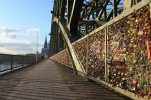-
#Bridges
Surprisingly, the Hohenzollern Bridge is one of the most recognizable objects in Cologne and is second only to the cathedral itself. Moreover, it's called the "Bridge of Love". Maybe because couples in love walk along with it and hang locks on the parapet with the assurance of the eternity of their feelings.
But back to engineering earthiness. The bridge assembled from steel beams. It stands on two piers and has three arches. The length of the main span is 167.75 meters, the total length is 409.19 meters, and the width is 29.5 meters.
It's simply amazing how the interweaving of steel channels, riveted and screwed together, create the effect of openwork in perspective. In this respect, the Hohenzollern Bridge reminds me of the Eiffel Tower.
The railway bridge needed to connect the right bank of the Rhine (read: the coal-mining Ruhr area) and the centre of Cologne, and the main station stood in the very centre it shares one square with the cathedral.
In 1859 it was built and named Cathedral (Dombrücke). It had six Romanesque turrets (four on the banks and two on supports in the middle of the Rhine). For its lattice structure, it was popularly called the "Mousetrap" (Muusfall). It was designed by hydraulic engineer Hermann Lohse.
It had two lanes for cars and two railway tracks. However, it soon became apparent that it wasn't able to handle the load, and after 48 years it was demolished to build a new version.
Prewar Hohenzollern Bridge
In May 1911, a new bridge was opened, which MAN had been building since 1907. The new bridge already had four railway tracks. It was already decorated with four neo-Romanesque turrets, which were designed by the Berlin architect Franz Schwechten. In addition, four equestrian monuments to the representatives of the Hohenzollern dynasty appeared at the bridge. Apparently because of the chosen name for the bridge. In general, the Hohenzollerns are a dynasty of the Electors of Brandenburg, and then of the kings of Prussia.
Hohenzollern Bridge to War
During the war, Cologne survived 262 bombings and was badly damaged, but still withstood. It was destroyed by American sappers on March 6, 1945.




